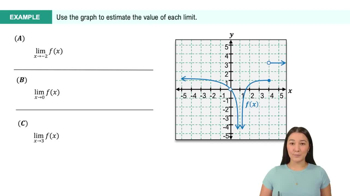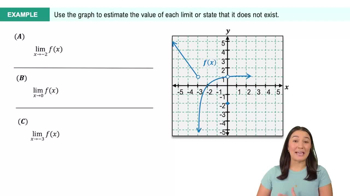Table of contents
- 0. Functions7h 52m
- Introduction to Functions16m
- Piecewise Functions10m
- Properties of Functions9m
- Common Functions1h 8m
- Transformations5m
- Combining Functions27m
- Exponent rules32m
- Exponential Functions28m
- Logarithmic Functions24m
- Properties of Logarithms34m
- Exponential & Logarithmic Equations35m
- Introduction to Trigonometric Functions38m
- Graphs of Trigonometric Functions44m
- Trigonometric Identities47m
- Inverse Trigonometric Functions48m
- 1. Limits and Continuity2h 2m
- 2. Intro to Derivatives1h 33m
- 3. Techniques of Differentiation3h 18m
- 4. Applications of Derivatives2h 38m
- 5. Graphical Applications of Derivatives6h 2m
- 6. Derivatives of Inverse, Exponential, & Logarithmic Functions2h 37m
- 7. Antiderivatives & Indefinite Integrals1h 26m
- 8. Definite Integrals4h 44m
- 9. Graphical Applications of Integrals2h 27m
- 10. Physics Applications of Integrals 2h 22m
1. Limits and Continuity
Introduction to Limits
Problem 2.7.17
Textbook Question
Suppose |f(x) − 5|<0.1 whenever 0<x<5. Find all values of δ>0 such that |f(x) − 5|<0.1 whenever 0<|x−2|<δ.
 Verified step by step guidance
Verified step by step guidance1
Step 1: Understand the problem statement. We are given that |f(x) - 5| < 0.1 for 0 < x < 5. We need to find a δ > 0 such that |f(x) - 5| < 0.1 whenever 0 < |x - 2| < δ.
Step 2: Recognize that this is a problem about continuity and limits. Specifically, it is related to the definition of a limit at a point, where we want to ensure that f(x) is close to 5 when x is close to 2.
Step 3: Consider the interval 0 < x < 5. Since we want 0 < |x - 2| < δ, we are focusing on values of x that are close to 2 but still within the interval (0, 5).
Step 4: Choose δ such that the interval (2 - δ, 2 + δ) is contained within (0, 5). This ensures that for any x in (2 - δ, 2 + δ), the condition 0 < x < 5 is satisfied, and thus |f(x) - 5| < 0.1 holds.
Step 5: Determine the largest possible δ by considering the boundaries of the interval (0, 5) and the point x = 2. The largest δ will be the minimum of the distances from 2 to the endpoints of the interval (0, 5).
 Verified video answer for a similar problem:
Verified video answer for a similar problem:This video solution was recommended by our tutors as helpful for the problem above
Video duration:
2mPlay a video:
Was this helpful?
Key Concepts
Here are the essential concepts you must grasp in order to answer the question correctly.
Epsilon-Delta Definition of Limit
The epsilon-delta definition of a limit formalizes the concept of limits in calculus. It states that for every ε (epsilon) greater than 0, there exists a δ (delta) such that if the distance between x and a point a is less than δ, then the distance between f(x) and L (the limit) is less than ε. This definition is crucial for understanding continuity and limits in calculus.
Recommended video:

Definition of the Definite Integral
Absolute Value Inequalities
Absolute value inequalities express the distance between two values. The inequality |f(x) - 5| < 0.1 indicates that the function f(x) is within 0.1 units of the value 5. Understanding how to manipulate and interpret these inequalities is essential for solving problems related to limits and continuity.
Recommended video:

Average Value of a Function
Neighborhoods in Calculus
In calculus, a neighborhood around a point a is defined as the set of all points within a certain distance from a. Specifically, the notation |x - 2| < δ describes a neighborhood around the point x = 2. This concept is important for establishing conditions under which a function behaves predictably, particularly in the context of limits and continuity.
Recommended video:

Fundamental Theorem of Calculus Part 1

 6:47m
6:47mWatch next
Master Finding Limits Numerically and Graphically with a bite sized video explanation from Callie
Start learning





